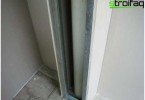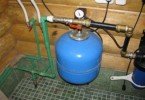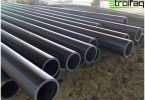Do-it-yourself well in the country
A rural area without water is a small desert. Neither to destroy a flower bed, nor to equip a pool, nor other civilization benefits that are usual and simply necessary for a person, related to water supply. There can be only one way out in this situation – a well at the cottage with your own hands or on order. It all depends on the availability of money and the desire to work. If you are full of energy and enthusiasm, then such a troublesome task as arranging a well in the country will be on your shoulder. Let’s look at what kind of wells can be and what is the difference between them..
Content
- Types of wells for autonomous water supply
- The simplest Abyssinian well
- Economical sand well
- Artesian well – operational long-term
Types of wells for autonomous water supply
The simplest Abyssinian well
This is a driven or needle hole that you can drill yourself. It is suitable for the area where the aquifer lies at a depth of 3-12 m. It is important that there are no sedimentation tanks, cesspools, septic tanks, landfills and other polluting sources nearby (within a radius of 30 m from the well)..
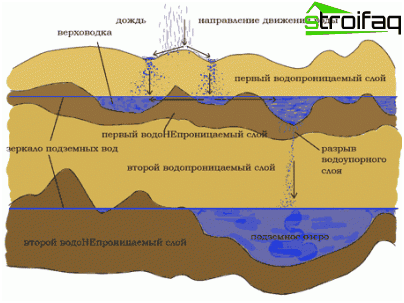
It is very important to choose the right place for the Abessian well
For such a well, you will need pipes, a plug-in filter, a borehole, a headstock with a headboard, a clamp. A well is drilled both in the yard and in the basement of the house itself. Then it will be possible to use water even in winter. And if you put both a pump and a hand column at the output, you can provide yourself with water even in times of lack of electricity.
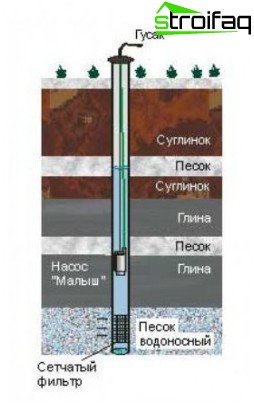
Typical sand well design
Economical sand well
Such a well is drilled to extract water from a sandy aquifer, which is usually located at a depth of up to 50 m. The volume of produced water is enough for one section. But water quality needs to be checked periodically..
Also relevant and the above rule on the need for remoteness of the well from sources of groundwater pollution. The coarse water filter located at the very bottom of the well needs to be cleaned regularly. The service life of such a well is 10-15 years..
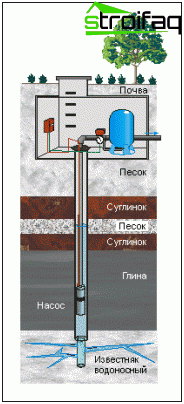
Typical artesian well design
Artesian well – operational long-term
In areas where there is a limestone formation, it is possible to extract water from it. You can find out about the presence of such a layer either from neighbors (are there artesian wells in the district?), Or by ordering an experimental well from specialists. It is not possible to drill such a well on its own, because the depth of the aquifer limestone is 30-200 m. Ordering the appropriate work from specialists is quite expensive. But providing such a supply of water at your site, you can be sure that your children and grandchildren will not have water problems. To pump water from such a well, a metal caisson tank is needed, in which a pump and a hydraulic accumulator are installed. Underground pipes can hold water in the house. Saving money will become possible if you collect funds from several summer cottages to drill wells in the country. Then water supply in the country from the well will not be a dream, but a reality.
How to drill a well in the country?
To provide the site with water, you need to determine what volumes of water (debit) you are interested in. If it is about 10 cubic meters. per hour, then you can’t do without an artesian well. If it is 1-1.5 cubic meters. per hour, you can stop at the Abyssinian well and a sand well. Moreover, you can drill them yourself. On how to make a well in the country, and will be discussed further.
The place for the well is chosen not too far from the house – no more than 3 m. Then it will be easier to lay a water supply. If there were already sand wells on the site, then the new one needs to be drilled away from the old.
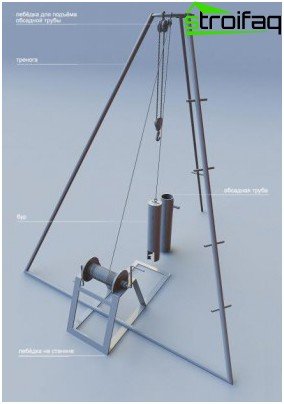
Tripod with a winch for drilling wells
What do home drillers need?
For drilling do-it-yourself wells will need:
- drill rig – a tripod made of strong logs or metal pipes and a winch attached to it for lowering and raising the drilling tool;
- drilling tool (consists of a drill column, core pipe, drill rods);
- drill (for different types of soil, a drill bit, a drill spoon, a chipper, a coil are used);
- shovels.
Self Drilling Process
In the place intended for the well, a pit is excavated, the so-called pit, the size of which is 1.5×1.5 m. To prevent wall sprinkling, they are sheathed with boards or plywood. Install the rig (tripod). You can use the finished one, or you can craft it yourself from three logs with a diameter of up to 15-20 cm. A winch is fixed in the place where the logs are attached. A drilling column can consist of three, four or more meter rods fastened with thread (sleeve) into one pipe and equipped with clamps for lowering and lifting. If the well is planned to be shallow, then one and a half meter rods can be dispensed with without using a tripod. The diameter of the core pipe depends on the diameter of the future pump. The gap between them should be at least 5 mm. The most suitable pipes with a diameter of 114 – 219 mm.
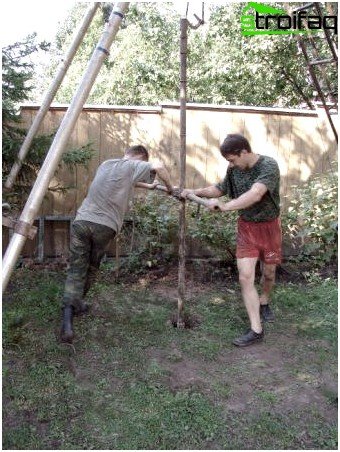
The process of rotary hammer drilling
Drilling of wells is carried out by rotational-shock method. In order to drill a well, the efforts of two people are needed, which will twist the bar. One person turns the rod with a pipe (gas) key, and the second one hits the rod with a hammer, punching the rock. An even more effective way: two scroll the bar, and two with the help of a winch raise and lower it in the well, punching the rock.
On the bar itself, you need to put marks. After all, after 50-60 cm, the drill needs to be pulled out and cleaned of soil. Drilling is a rock-dependent process. Therefore, when drilling wells, you need to use different types of drills. The presence of a water-containing formation will be indicated by the presence of moisture in the rock removed from the well. Upon reaching the appropriate water level, the well is cleaned of sand and solid inclusions by the bailer and flushing pump.
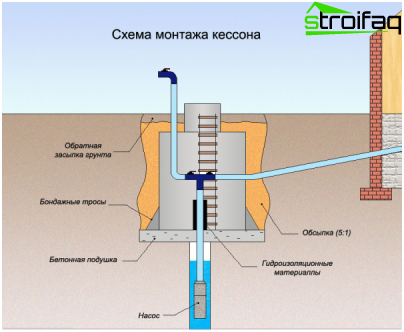
Diagram of a caisson device and connecting a well to an autonomous water supply system
Equipment for an autonomous water source
For well equipment you will need:
- casing pipe (metal, plastic);
- filter;
- pump;
- safety cable;
- waterproof cable;
- pipe or hose for lifting water;
- valve;
- caisson.
The well is equipped with a filter column consisting of a filter and a casing. The filter is made of casing by wrapping the perforation with a filter mesh. Water is pumped through the casing and the filter is flushed..
The pump is preselected. After all, its dimensions should correspond to the diameter of the casing. Also, when choosing a pump, it is important to consider the debit of the well, the depth of the water, the load on the pump, which depends on the depth of the well itself and its remoteness from the house. If the well depth is more than 9 m, then use a borehole pump, if less – then the surface self-priming.
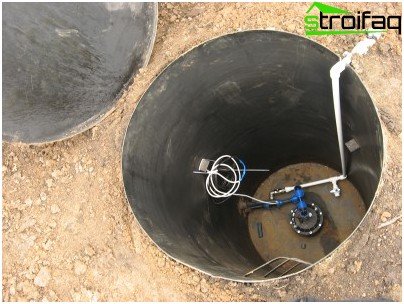
Caisson device – a tank used to install equipment and to service an aquifer
The submersible pump is lowered into the well fixed on a safety cable or pipe. A cable, which must be water resistant, and a water pipe (or hose) are attached to the pump. The diameter of such a pipe can be 25, 40, 50 mm, depending on the debit of the well. The pipe is discharged at the wellhead and hermetically welded to the end of the caisson. The water supply is regulated by a valve, which is installed on the pipe. Caisson is covered with earth from the sides. You can now get to the well only through the manhole cover on the ground. From the caisson along the trench, water is carried into the house.
How to clean a well in a country house?
Long operation of the well over time leads to its clogging. How do we know about this? From the tap! The flow of water decreases, the water comes out with air, jerks, impurities, silt, sand are present in the water. If you do not “cure” such a well in time, you will have to dig a new one. How to clean wells? There are several of them.
Using an air compressor. A vacuum plug is created on the well pipe. A compressor is connected to it and a well is blown through it under high pressure. This method is good for cleaning sludge. If, in addition to silt, iron and calcareous deposits are present, then the purge will be ineffective.
Using a water compressor. The well is washed under strong water pressure. Effectively it is only against silt and sand.

Short-circuit cleaning scheme
Revolutionary can be called the method of explosion by means of a short circuit. To do this, the power cord is separated (2), threaded into a plug (5), the wires are exposed, they are pushed apart and connected with a thin thread of copper (2). This device is inserted into the medicine bottle (4), filled with smoky gunpowder (3) and hermetically closed with a stopper. This device is lowered to the bottom of the well (1), attaching a weight. As a sinker, you can use a piece of lead or a steel pipe. Next, the plug (8) from the power cord is connected to a 220 W network and immediately turned off. An explosion will occur in the well. It is safer to conduct such experiments with a half-filled bubble twice in a row. If water goes, then you can stop, if not, then already use a full bubble.
Using acid. After the well is purged with a compressor, acid is poured into it. The method is very dangerous, so a person needs to protect his face, eyes, and wear a respirator. Since you can’t find acid now in the daytime with fire, people got the hang of using acid for batteries. Once acid has been poured into the well, plug it for a couple of days. After a while, again armed with protective equipment, the plug is removed. By connecting the pump, pump water for 7 hours. After this procedure, you can drink it only after a month, and if earlier – then only after additional filtration.
As you can see, there are a lot of shortcomings in self-cleaning wells. Therefore, in order to save the well and clean it as much as possible, resort to the services of professionals. Otherwise, instead of being useful, it is possible to harm and, through inexperience, destroy pipes. “The avaricious pays twice,” says folk wisdom. Therefore, it is better to pay specialists in cleaning and repair of wells once every 10 years than to dig a new one later..



